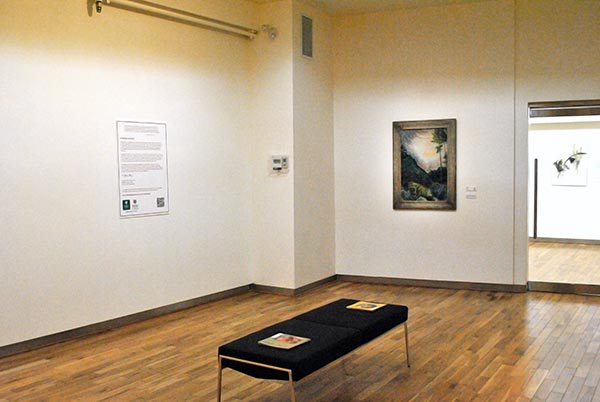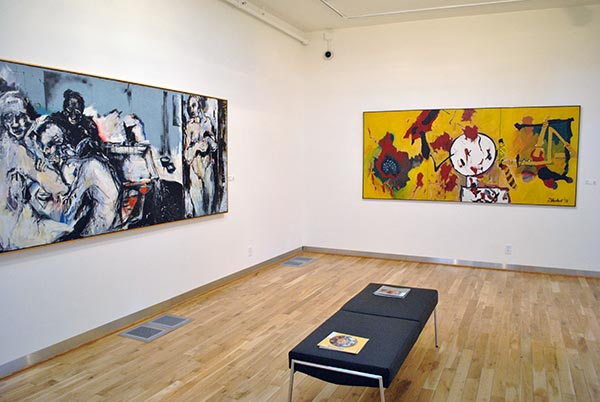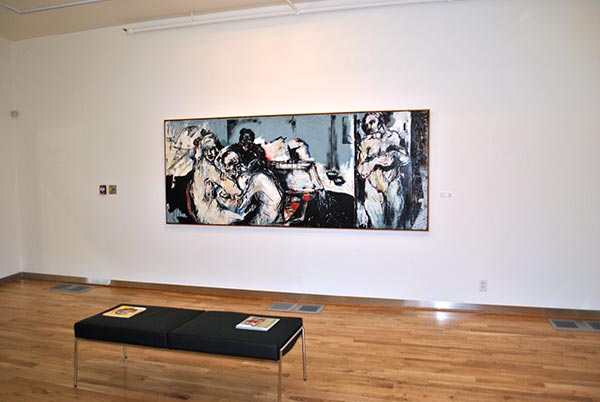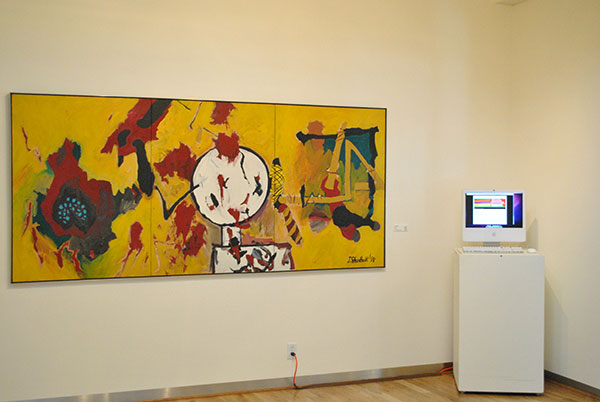Legacy Gallery
(2008-2014)
Since I joined the faculty at the University of Victoria, my role has been to conceive curatorial projects, then work with graduate and undergraduate students in my seminars to create exhibitions at the Legacy Gallery. In many cases, this is the first time students have worked on a group project, and most have not had any curatorial experience. The production of these exhibits requires a concentrated effort within the short span of just twelve weeks, in which we develop a theme, write labels, devise an installation plan, refine an image list, and design a promotional program. The exhibits produced during the first two years of my appointment, A Walk Through the City: Experiencing Victoria as Flâneur (2009) and Regarding Wealth (2010), featured work from the Michael Williams Art Collection and focused on working through processes of collaborative design. The exhibits of the third and fourth years, Connect the Blocks (2011) and On Communities and Nations (2012), were created in conjunction with an installation of art at the Cool Aid Health Center (See: Access Art link). For additional details about my exhibition program, please see “Creating Metaculture: Community-based work with the University of Victoria’s Michael Williams Bequest,” University Museums and Collections Journal, 2010 3: 53-59. Click here to access the article.
A Walk Through the City: Experiencing Victoria as a Flâneur
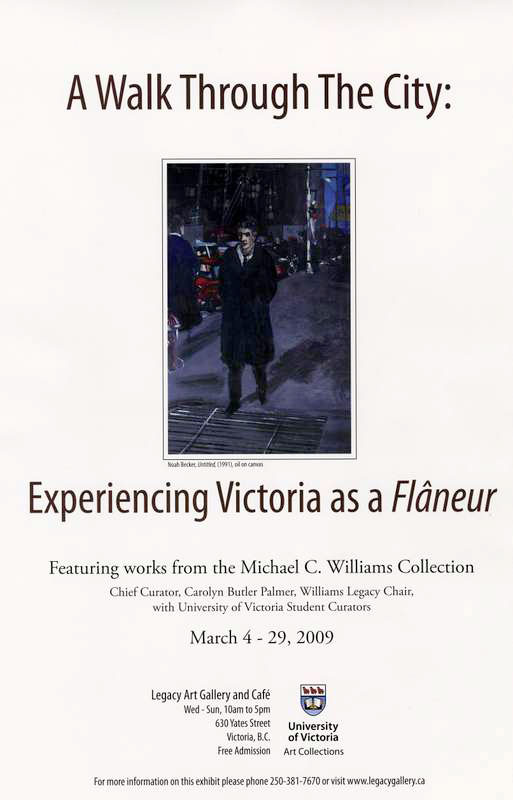
Urban environments offer diverse settings for a diverse audience. As we walk through the city, we share these various spaces with thousands of fellow city-dwellers, and we remain anonymous as we interact with the environment and crowds around us. The flâneur was originally a romantic figure of 19th century Paris who would walk through city space observing and drawing inspiration from the experience. The term flâneur - from the French verb flâner, meaning “to stroll” - can now be applied to any urban pedestrian environment where different types of people interact. Michael Williams, the donor of many pieces in this collection, was a driving force in the revitalization of downtown Victoria. A business man, developer and heritage conservator, Williams is an excellent example of a flâneur, someone who enjoyed experiencing the beauty of the city in which he lived. The artworks are divided into four themes: Moving Through City Space, Anonymity, People Watching and Ephemeral Features. As you enter this room, you are challenged to experience the artworks anonymously and with a heightened sense of awareness. Have we captured your own experiences in the city?
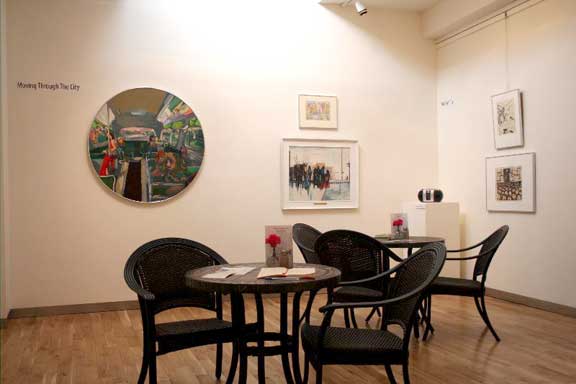

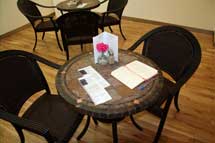
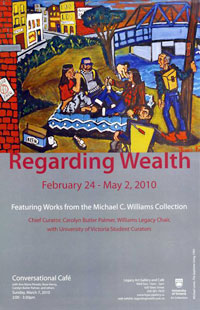
This exhibition is part of an ongoing series of projects and class seminars featuring artwork from the University of Victoria’s Michael Williams Collection led by Dr. Carolyn Butler-Palmer who occupies the Williams Legacy Chair.
Last semester, students discussed and debated the intersections between art and homelessness and how to most effectively and empathetically develop an exhibition on this topic. In addition to class discussion there were several projects fulfilled by the students that can now be viewed on the website or experienced in the Legacy Gallery. The class was separated into groups to collect oral histories of people in Victoria who work with the homeless community or have made art dealing with the subject.
The final project was entirely different. Each student selected a piece of art from the Williams Collection and investigated the works provenance, the artists’ oeuvre, and the way in which the work explored the subject of wealth. The students wrote an essay and created in-depth research portfolio about their process of learning about their artwork.These research portfolios can be viewed online or in the gallery.
In the winter seminar of Dr. Carolyn Butler-Palmer’s the focus of the class was to actually curate the exhibition that had been discussed in the previous semester. To make the project more manageable, the class was broken up into four groups: Installation, Labels, Public Relations, and Web Design. The Installation team was given the task of choosing the images for the exhibition, their placement in the gallery, and to create a cohesive message that questions the different concepts of wealth. The Label group was in charge of creating all of the text panels, labels, and to select research questions for specific artworks to give the viewer points of reflection with different works. Public Relations was in charge of putting together press releases for the exhibition as well as the Conversational Café, and to create promotional material for the exhibition. The Web Design group created a website that accompanied the exhibition and communicated its message, displayed the work that was included along with the previous research from earlier classes, and to make it accessible to a wider audience.
The next stage of this project is a seminar to be held in 2010-11 that will focus on therapeutic curating at ACCESS Health, Cool-Aid’s new health facility for indigent residents of Victoria.
"Regarding Wealth Exhibit- Audio" - Conversation Cafe', March 7, 2010


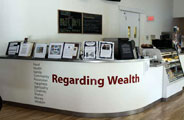
"Exhibit Shines Light on Victoria Art" - Times Colonist, April 14, 2010
"Art Show Analyzes Intersection of Art and Homelessness" - Nexus Newspaper, March 21, 2010
"Regarding Wealth Exhibit" - A Channel, March, 2010
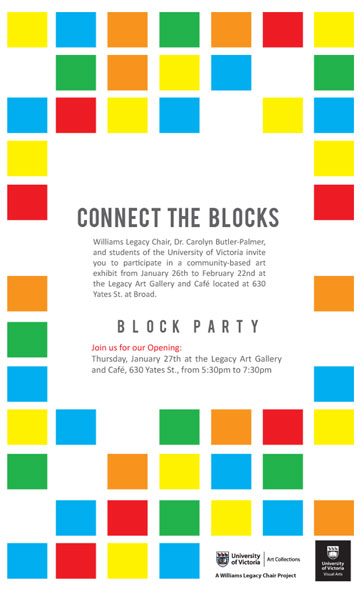
Connect the Blocks explores the intersections between art, community, and well-being. We ask you to think how art affects your life and community. What would your life be like without art? What role does art play in your community? Can art help create community? Does art enrich your life or contribute to your health? Can our community be healthy without art? We ask you to engage these questions by helping us make a colourful mosaic. Use the provided crayons and paper blocks to make your own miniature work of art. Then, connect your block to others by inserting it into the mosaic on the back wall. Help us to create community and to communally curate. Connect the Blocks is inspired by Michael Williams, who gave this building as part of his generous bequest to the University of Victoria. Williams is also known for his many good works. He provided support to the homeless, sponsored art projects, and helped create a vibrant community in downtown Victoria. We hope you enjoy Connect the Blocks!

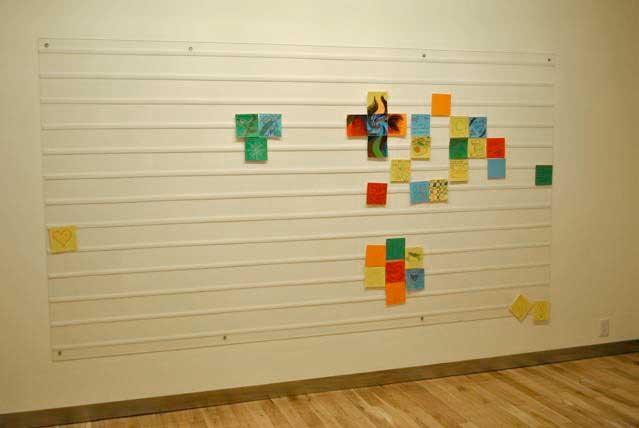
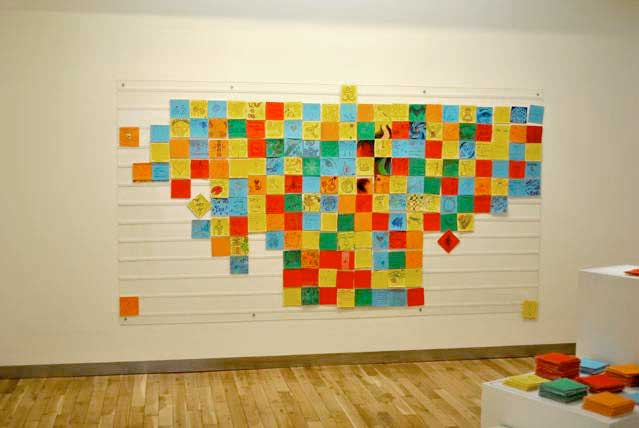
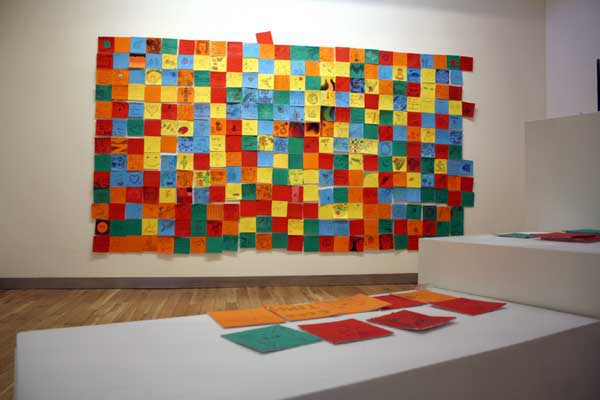
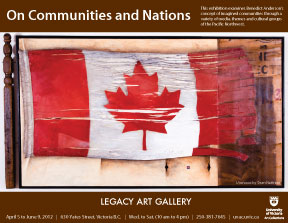
WHAT IS THE RELATIONSHIP BETWEEN COMMUNITY AND NATIONHOOD? According to historian Benedict Anderson, some nations are created through a spiritual connection to the land and are built through everyday face-to-face relationships. These are “community nations.” By contrast, Anderson sees nation states as “imagined political communities” which are too large to be created through personal relationships. Public venues such as cafés and tools such as the printing press allow citizens of a nation state to create community through the development of shared values and images. On Communities and Nations engages with Anderson’s idea of the nation state as an imagined community. The opening section, “The Nation State as Community” visualizes the mechanisms that allow communities to be imagined: coffee houses and the press allow for the creation of shared sets of symbols, such as flags. The second section, “Community Nations” calls attention to the phenomenon of First Nations fine art prints. Since the Second World War, these prints have also carried the popular imagination toward the idea of a community nation.
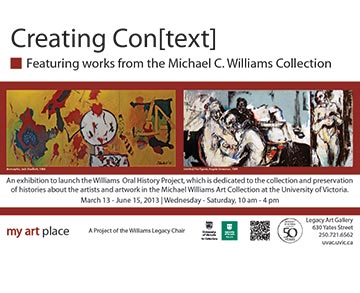
[Michael Williams] was very interested in nurturing the idea that there was a movement that I was a part of, because I never really considered that I was. I thought I was an anomaly, that I just happened to be here, that I was not part of any fabric. Even when I saw the pieces and I thought, these things have nothing to do with what I am interested in and they’re nothing like me…now I look back and see Shadbolts….and I think well hold on, what we do is all connected
Angela Grossman 2010.
Stories help us understand the contexts and meanings of artwork. However, works of art are often separated from the very stories that activate them. Oral art history is the practice of collecting, recording, and preserving stories about works of art, ensuring their vitality for future generations. Creating Con[text] is about the process of making, maintaining, and mobilizing stories about works of art in the University of Victoria’s Michael Williams Collection.
I initiated the Williams Oral History Project shortly after I came to the University of Victoria as Williams Legacy Chair. Inspired and intrigued by Michael Williams’ vision, I wanted to find the living legacy of the works of art he so carefully collected. As a newcomer to Victoria, I sought out the community of people who knew much about Michael and his passion for art, and it was through their stories that the Williams Collection came to life.
The Williams Oral History Project is designed to commit these narratives to text as a means of preserving and activating them. Creating Con[text] visualizes contemporary Vancouver artist Angela Grossman’s history of her (Untitled: Five Figures) painting, allowing us to recognize her work within a larger continuum of Pacific Northwest art tradition that includes most significantly Emily Carr and Jack Shadbolt.
